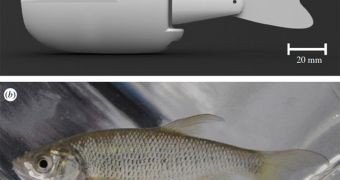An international collaboration of scientists announces the development of a robotic fish that could easily infiltrate fish schools in their natural environments. This instrument could help reveal some of the things scientists still don't know about the social behavior of marine animals.
As evidenced in the video below, a Golden shiner fish had no trouble accepting the robotic contraption as a companion while swimming against an artificially created current. At this point, some experts envision the robotic fish as a tool to avert ecological disasters.
Multiple fish species and habitats are currently threatened by a variety of factors, including ocean acidification, overfishing, excessive underwater noises, pollution and so on. Conservation specialists are clinging on to whatever methods they have at their disposal to prevent ecosystemic collapse.
This is one of the first investigations to produce a machine that simulates the locomotory patterns of a fish species. Other studies did manage to successfully study the interactions between species living in the wild and robots, but never with such a degree of accuracy or complexity.
University of Montpellier investigator Stefano Marras conducted the new study with fellow researcher Maurizio Porfiri, who is based at the New York University (NYU) Polytechnic Institute, Wired reports.
Details of how their robotic fish was built were published in the February 22 online issue of the Journal of the Royal Society Interface. Now, experts plan to use the robot to determine both the advantages and disadvantages of fish schools with a higher degree of certainty.
Some of the advantages include easy access to mates, reduced drag while swimming forwards through the water, as well as the ability to confuse predators, to some extent. On the other hand, the level of intra-group competition skyrockets in such a setup.
“If accepted by the animals, robotic fish may act as leaders and drive them away from human-induced ecological disasters that are affecting life in aquatic environments, such as oil spills, and man-made structures, such as dams,” the research group writes in the new journal entry.
During the experiments, some of the fish kept their distance from the robot, most likely perceiving it as a threat. But others followed in its wake, in order to reduce drag and swim more efficiently. Such an instance is depicted in the video below.

 14 DAY TRIAL //
14 DAY TRIAL // 